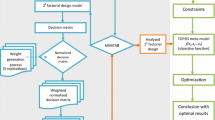Abstract
This paper presents a methodology for structural design optimization of multiple objectives, or attributes. The method represents an improvement over Pareto optimizationbased methods by quantitatively representing trade-offs between conflicting objectives in a single multi-attribute objective function. Classical utility analysis is first used to determine a multi-attribute evaluation function for a particular structure from the designer's viewpoint. This viewpoint takes into account the attribute tradeoffs that are appropriate for a specific project. Since attributes are controlled only indirectly through specification of design decision variables, a new objective function is then formulated which expresses design utility directly in terms of those parameters over which the designer has direct control. A one-bay, three storey steel frame building example demonstrates the methodology for determining the design configuration with the best combination of cost and drift index.
Similar content being viewed by others
References
Ad Hoc Committee on Serviceability Research, Committee on Research of the Structural Division 1986: Structural serviceability: a critical appraisal and research needs.J. Struct. Eng. ASCE 112, 2646–2664
AISC 1986:Load & resistance factor design, manual of steel construction
Andam, K.A.; Knapton, J. 1980: Optimum cost design of precast concrete framed structures.Eng. Opt. 5, 41–50
ASCE 1990:Minimum design loads for buildings and other structures
Cohn, M.Z.; MacRae, A.J. 1984: Optimization of structural concrete beams.J. Struct. Eng. ASCE 110, 1573–1588
Corner, J.L.; Kirkwood, C.W. 1991: Decision analysis applications in the operations research literature.Operations Research 39
Council on Tall Steel Building & Urban Habitat 1979:Structural design of tall steel buildings. New York: ASCE
de Neufville, R. 1990:Applied systems analysis. New York: McGraw-Hill
Eschenauer, H.; Koski, J.; Osyczka A. 1990:Multicriteria design optimization: procedures and applications. Berlin, Heidelberg, New York: Springer
Fenves, S.J. 1991: Needs and opportunities in computer-aided structural engineering.Proc. Ninth Structures Cong. (held in Indianapolis). New York: ASCE
Fishburn, P.C. 1970:Utility theory for decision making. New York: Wiley
Foreman, M.M. 1975:Wind drift criteria currently employed in tall building design. Masters Thesis, Massachusetts Institute of Technology, Cambridge, Mass
Galambos, T.V.; Ellingwood, B. 1986: Serviceability limit states: deflection.J. Struct. Eng. ASCE 112, 67–84
Goh, C.J.; Wang, C.M. 1989: A unified approach to optimization of structural members under general constraints.Struct. Optim. 1, 215–226
Gu, Y.; Cheng, G. 1990: Structural shape optimization integrated with CAD environment.Struct. Optim. 2, 23–28
Jacobs, T.L. 1991: Chance-constrained optimization model for structural design.J. Struct. Eng. ASCE 117, 100–110
Jendo, S. 1990: Multicriteria optimization of concrete beams, trusses, and cable structures. In: Eschenauer, H.; Koski, J.; Osyczka, A. (eds.)Multicriteria design optimization: procedures and applications. Berlin, Heidelberg, New York: Springer
Kanagasundaram, S.; Karihaloo B.L. 1990: Minimum cost design of reinforced concrete structures.Struct. Optim. 2, 173–184
Keeney, R.L.; Raiffa, H. 1976:Decisions with multiple objectives: preferences and value trade-offs. Chichester: Wiley and Sons
Kirsch, U. 1983: Multilevel optimal design of reinforced concrete structures.Eng. Optim. 6, 207–212
Koski, J.; Silvennoinen R. 1987: Norm methods and partial weighting in multicriterion optimization of structures.Int. J. Num. Meth. Eng. 24, 1101–1121
Levy, R.; Lev O.E. 1987: Recent developments in structural optimization.J. Struct. Eng. ASCE 113, 1939–1962
Lin, T.Y.; Stotesbury S.D. 1981:Structural concepts and systems for architects and engineers. Chichester: John Wiley & Sons
Luce, R.D.; Raiffa H. 1957:Games and decisions. New York: Wiley
Means 1989:Building construction cost data 1990
Murotsu, Y.; Shao, S. 1990: Optimum shape design of truss structures based on reliability.Struct. Optim. 2, 65–76
Newmark, N.M.; Rosenblueth, E. 1971:Fundamentals of earthquake engineering. Englewood Cliffs: Prentice-Hall
Ohno, T.; Kramer, G.J.E.; Grierson, D.E. 1989: Least-weight design of frameworks under multiple dynamic loads.Struct. Optim. 1, 181–191
Olhoff, N. 1989: Multicriterion structural optimization via bound formulation and mathematical programming.Struct. Optim. 1, 11–17
Osyczka, A. 1984:Multicriterion optimization in engineering with FORTRAN programs. Chichester: Ellis Horwood
Osyczka, A. 1985: Multicriteria optimization for engineering design. In: Gero, J.S. (ed.)Design optimization, pp. 193–227. New York: Academic Press
Pratt, J.W.; Raiffa, H.; Schlaifer, R.O. 1965:Introduction to statistical decision theory. New York: McGraw Hill
Radford, A.D.; Gero, J.S.; Roseman, M.A.; Balachandran, M. 1985: Pareto optimization as a computer-aided design tool. In: Gero, J.S. (ed.)Optimization in computer-aided design. Amsterdam: Elsevier
Radford, A.D.; Gero, J.S. 1988:Design by optimization in architecture, building, and construction. New York: Van Nostrand Reinhold Company
Ridha, R.A.; Wright R.N. 1967: Minimum cost design of frames.J. Struct. Div. Proc. ASCE 93, 165–183
Salmon, C.G.; Johnson J.E. 1990:Steel structures: design and behavior. New York: Harper & Row
Savage, L.J. 1954:The foundations of statistics. New York: Wiley
Spires, D.; Arora, J.S. 1990: Optimal design of tall RC-Framed tube buidings.J. Struct. Eng. ASCE 116, 877–897
Thurston, D.L. 1991: A formal method for subjective design evaluation with multiple attributes.Research in Engineering Design 3, 105–122
Thurston, D.L.; Carnahan, J.; Liu, T.L. 1991: Optimization of design utility.Proc. ASME Conf. on Design Theory and Methodology (held in Miami, FL)
Thurston, D.L.; Liu, T. 1991: Design evaluation of multiple attributes under uncertainty.Sys. Auto. Res. Appl. 1, 143–159
von Neumann, J.; Morgenstern O. 1947:Theory of games and economic behavior, 2nd ed. Princeton N.J.: Princeton University Press
Watson, S.R.; Buede D.M. 1987:Decision synthesis: the principles and practice of decision analysis. Cambridge: Cambridge University Press
Zionts, S.; Wallenius, J. 1976: An interactive programming method for solving the multiple criteria problem.Management Science 6, 652–663
Author information
Authors and Affiliations
Rights and permissions
About this article
Cite this article
Thurston, D.L., Sun, R. Structural optimization of multiple attributes. Structural Optimization 5, 240–249 (1993). https://doi.org/10.1007/BF01743586
Received:
Issue Date:
DOI: https://doi.org/10.1007/BF01743586




